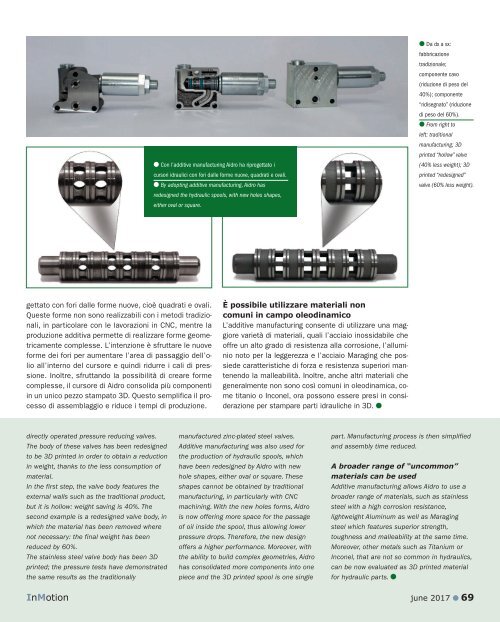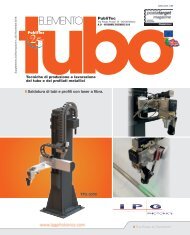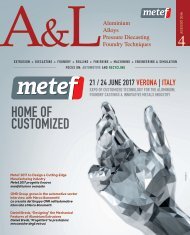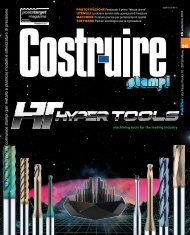Sfogliabile_InMotion_giugno_n34
You also want an ePaper? Increase the reach of your titles
YUMPU automatically turns print PDFs into web optimized ePapers that Google loves.
l Con l’additive manufacturing Aidro ha riprogettato i<br />
cursori idraulici con fori dalle forme nuove, quadrati e ovali.<br />
l By adopting additive manufacturing, Aidro has<br />
redesigned the hydraulic spools, with new holes shapes,<br />
either oval or square.<br />
l Da dx a sx:<br />
fabbricazione<br />
tradizionale;<br />
componente cavo<br />
(riduzione di peso del<br />
40%); componente<br />
“ridisegnato” (riduzione<br />
di peso del 60%).<br />
l From right to<br />
left: traditional<br />
manufacturing; 3D<br />
printed “hollow” valve<br />
(40% less weight); 3D<br />
printed “redesigned”<br />
valve (60% less weight).<br />
gettato con fori dalle forme nuove, cioè quadrati e ovali.<br />
Queste forme non sono realizzabili con i metodi tradizionali,<br />
in particolare con le lavorazioni in CNC, mentre la<br />
produzione additiva permette di realizzare forme geometricamente<br />
complesse. L’intenzione è sfruttare le nuove<br />
forme dei fori per aumentare l’area di passaggio dell’olio<br />
all’interno del cursore e quindi ridurre i cali di pressione.<br />
Inoltre, sfruttando la possibilità di creare forme<br />
complesse, il cursore di Aidro consolida più componenti<br />
in un unico pezzo stampato 3D. Questo semplifica il processo<br />
di assemblaggio e riduce i tempi di produzione.<br />
È possibile utilizzare materiali non<br />
comuni in campo oleodinamico<br />
L’additive manufacturing consente di utilizzare una maggiore<br />
varietà di materiali, quali l’acciaio inossidabile che<br />
offre un alto grado di resistenza alla corrosione, l’alluminio<br />
noto per la leggerezza e l’acciaio Maraging che possiede<br />
caratteristiche di forza e resistenza superiori mantenendo<br />
la malleabilità. Inoltre, anche altri materiali che<br />
generalmente non sono così comuni in oleodinamica, come<br />
titanio o Inconel, ora possono essere presi in considerazione<br />
per stampare parti idrauliche in 3D. l<br />
directly operated pressure reducing valves.<br />
The body of these valves has been redesigned<br />
to be 3D printed in order to obtain a reduction<br />
in weight, thanks to the less consumption of<br />
material.<br />
In the first step, the valve body features the<br />
external walls such as the traditional product,<br />
but it is hollow: weight saving is 40%. The<br />
second example is a redesigned valve body, in<br />
which the material has been removed where<br />
not necessary: the final weight has been<br />
reduced by 60%.<br />
The stainless steel valve body has been 3D<br />
printed; the pressure tests have demonstrated<br />
the same results as the traditionally<br />
manufactured zinc-plated steel valves.<br />
Additive manufacturing was also used for<br />
the production of hydraulic spools, which<br />
have been redesigned by Aidro with new<br />
hole shapes, either oval or square. These<br />
shapes cannot be obtained by traditional<br />
manufacturing, in particularly with CNC<br />
machining. With the new holes forms, Aidro<br />
is now offering more space for the passage<br />
of oil inside the spool, thus allowing lower<br />
pressure drops. Therefore, the new design<br />
offers a higher performance. Moreover, with<br />
the ability to build complex geometries, Aidro<br />
has consolidated more components into one<br />
piece and the 3D printed spool is one single<br />
part. Manufacturing process is then simplified<br />
and assembly time reduced.<br />
A broader range of “uncommon”<br />
materials can be used<br />
Additive manufacturing allows Aidro to use a<br />
broader range of materials, such as stainless<br />
steel with a high corrosion resistance,<br />
lightweight Aluminum as well as Maraging<br />
steel which features superior strength,<br />
toughness and malleability at the same time.<br />
Moreover, other metals such as Titanium or<br />
Inconel, that are not so common in hydraulics,<br />
can be now evaluated as 3D printed material<br />
for hydraulic parts. l<br />
<strong>InMotion</strong><br />
june 2017 l 69





